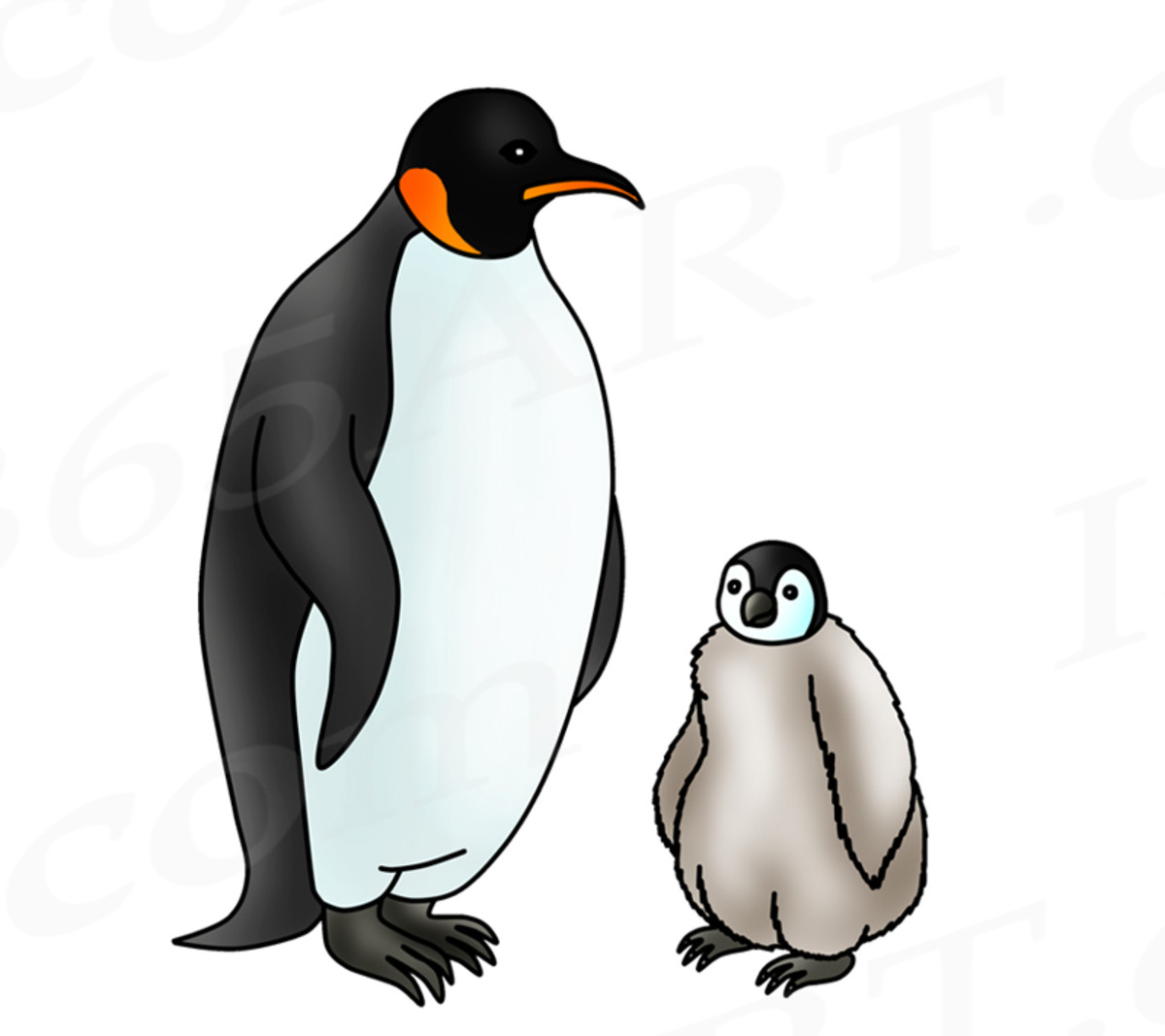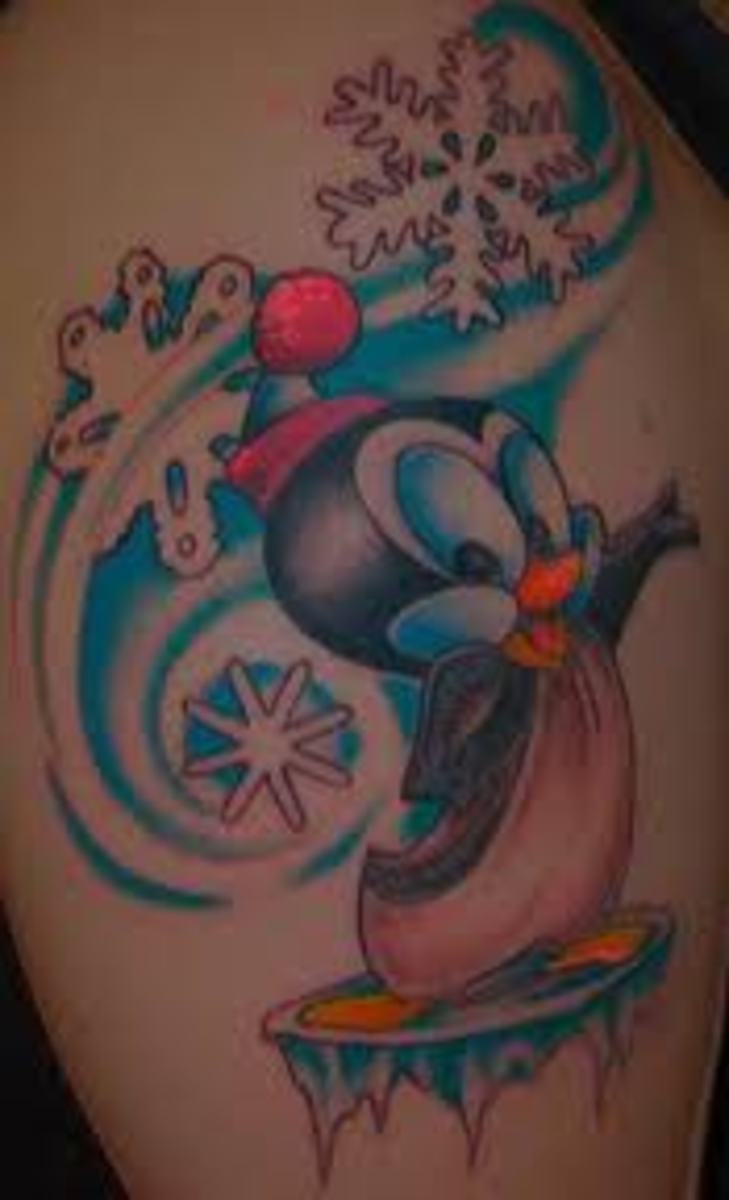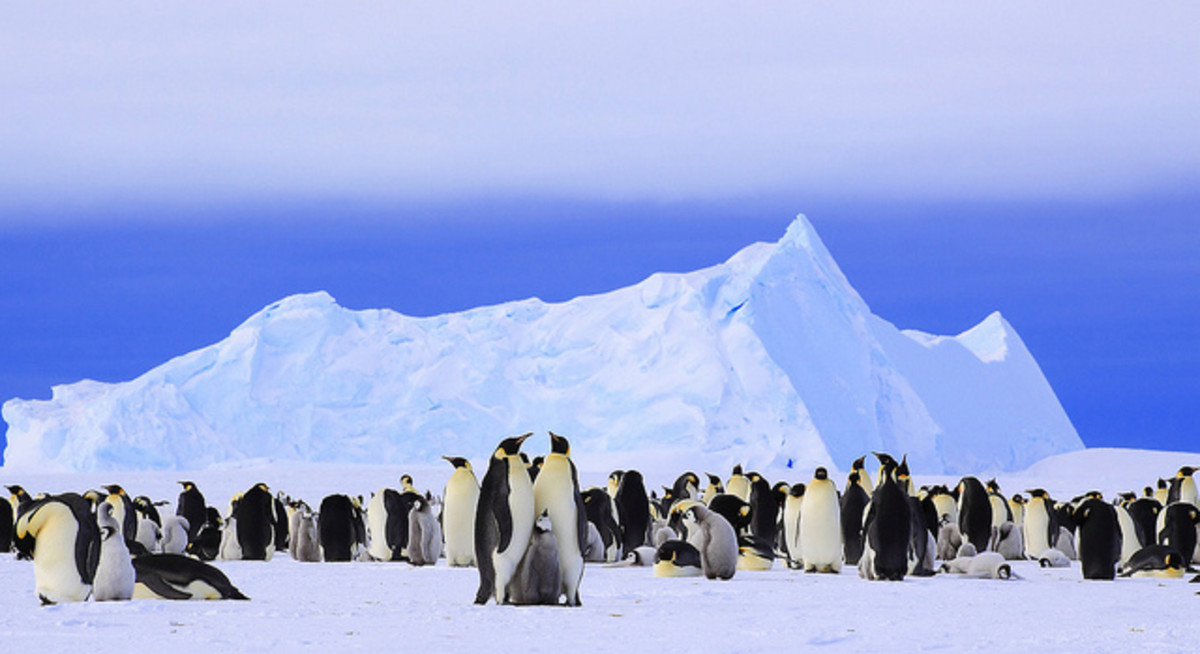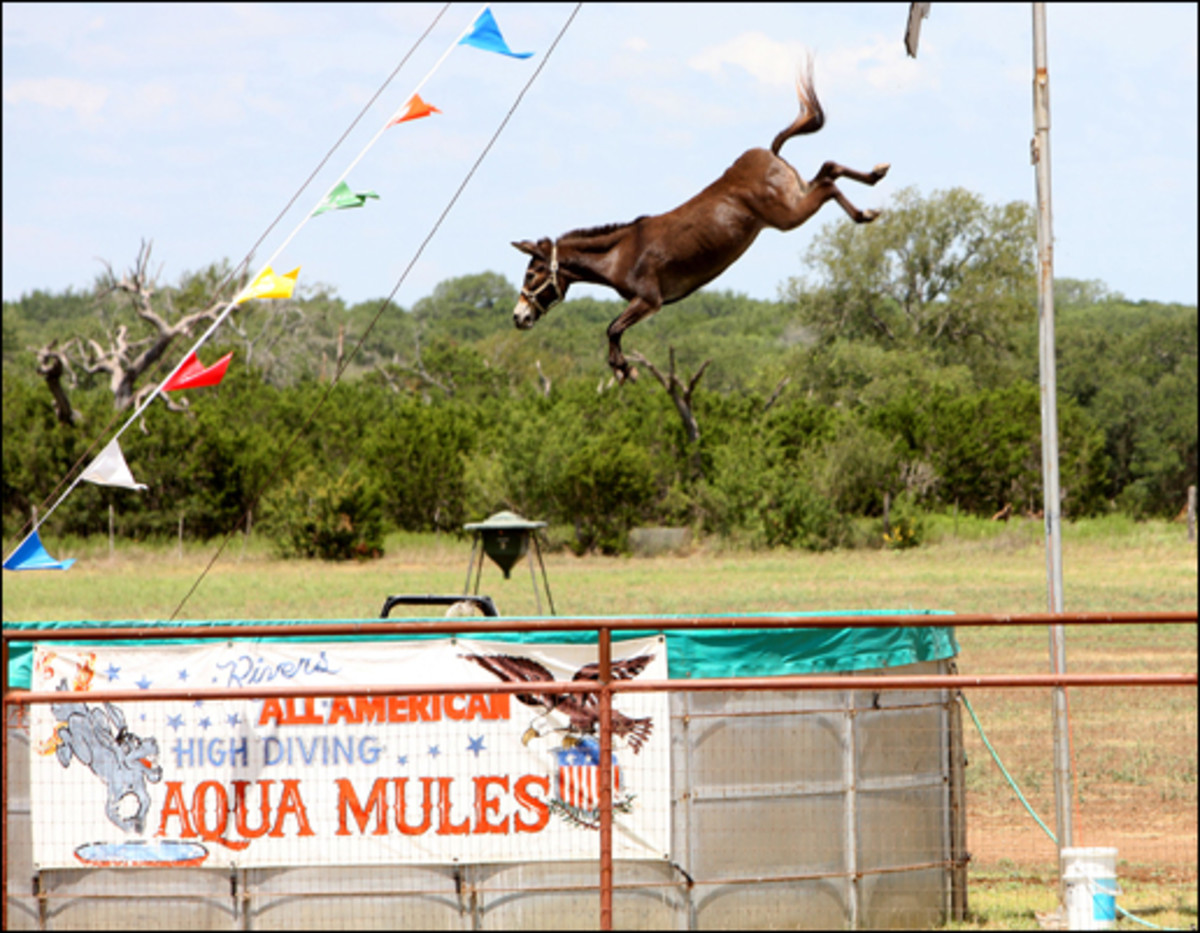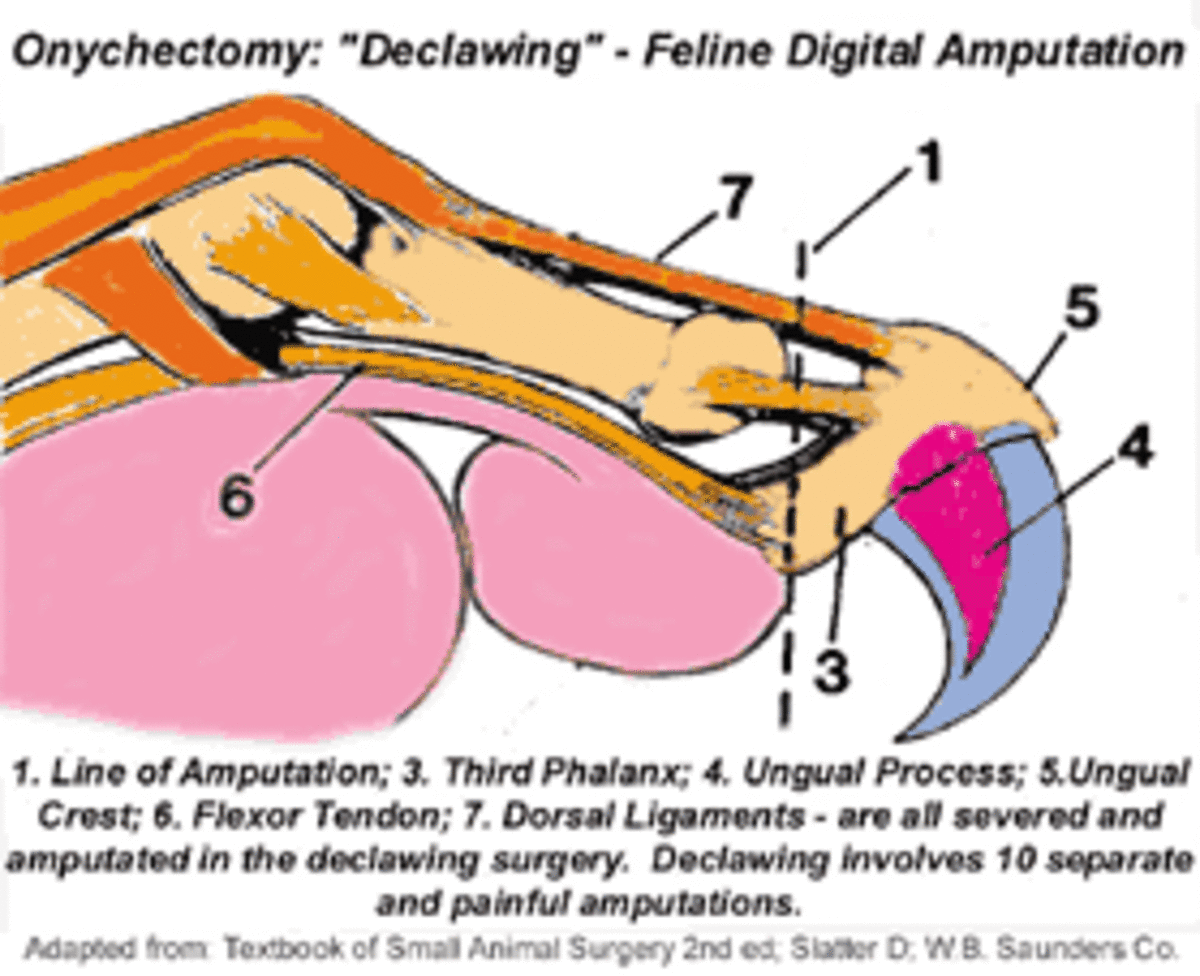The New Zealand Emperor Penguin named Happy feet ~ What is happening to Happy feet
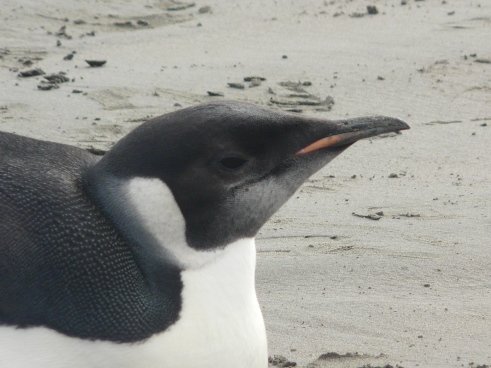
The Emperor penguin called Happy feet.
New Zealand’s Peka Peka Beach has had an unusual visitor a juvenile Emperor Penguin who has been fondly named Happy feet. He arrived from Antarctica on Monday 20th June 2011.
Although he appeared to be fine other than being tired from his long swim which was approx. 7,000 km. The locals have adopted him and gone as far as creating a roster so that someone is watching over him 24 hours a day.
It is the first time in 44 years an emperor penguin has visited New Zealand. The last wild Emperor in New Zealand was in 1967 at the southern Oreti Beach. The other emperor penguin was released in Foveaux Strait.
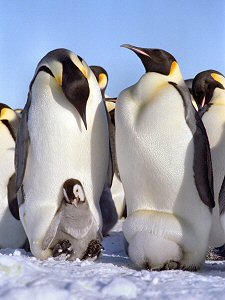
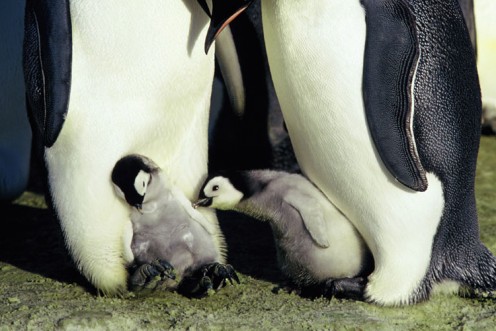
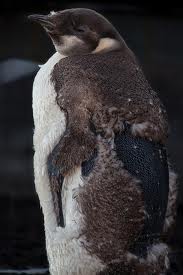
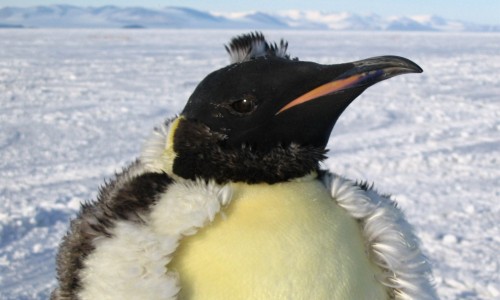
Emperor Penguin facts
There is estimated to be around 200,000 breeding pairs of emperor penguins in the world.
Emperor penguins reach breeding age at 4 years and they normally live to be 20 years old.
There have been a few cases recorded of Emperor penguins living to be over 40 years old though such extremes of longevity are rare.
The Emperor penguin is the only penguin species that breeds during the Antarctic winter.
The penguins travel over the ice as far as 120km to get to their nesting grounds.
Nesting grounds can have thousands of Penguins in each one.
The female penguin lays one egg which is kept warm by the male penguin.
Emperors are the largest penguins and they are only found in Antarctica.
Emperor penguins have brown eyes.
Male penguins stand together in a big huddle for up to 9 weeks while it is their turn to take care of the egg. They huddle together to escape from wind and keep themselves warm while the mothers walk the long way back to the ocean, feed for a few weeks then make the return trip to take care of their new baby.
Males eat nothing when taking care of their eggs. They can lose half their weight while keeping an egg warm. The only thing they do is eat snow to keep hydrated.
Young birds go to sea and don't return to their colonies until they are 4 years old.
Emperor penguins shed all their feathers in one go once a year. They stay ashore for 30-40 days until their new coat is sleek and waterproof again. During this time they don’t eat anything.
Penguins have more feathers than most birds; they have approx. 100 feathers per square inch.
The scientific name for Emperor penguins is ... Aptenodytes forsteri
Aptenodytes means 'featherless diver'
forsteri is the penguin’s species name. Johann Reinhold Forster (1729-98). Was a naturalist on Captain James Cook's voyage around the world. It is reputed that he was one of the first people to have given a written description of the Emperor penguins.
Lost Emperor penguin named Happy feet
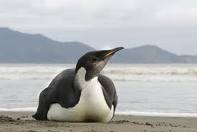
Tuesday 21st June
Hundreds of people have flocked to see Happy feet and I can happily say that everyone is following the department of conservation and his minders rules to not come too close to the penguin and to make sure he always has a clear path to the ocean. People truly can be thoughtful and loving. The news said he had created a march to the penguin which I thought was extremely well done of whoever actually said it first.
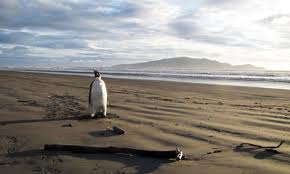
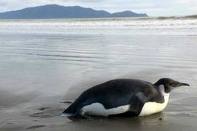
Wednesday 22nd June. ~
Happy feet has been estimated to be about 10 months old and about 80 centimetres tall.
Although penguins can spend months at sea at a time it is believed that Happy feet took a wrong turn and ended up here. No one knows if he came ashore for a break but the consensus is that he needs to head back home soon so he doesn’t become ill from being in too hot a climate.
Even the sea is hotter that the waters he is used to. He has been eating sand as he would be used to eating solid or powdered snow which would melt in its stomach. The penguin obviously doesn’t realise that the sand won’t melt. This is a concern as the sand could make him rather ill. It will also be a problem if he eats sticks or grasses which don't grow in Antarctica. He could eat small sticks believing they are fish.
March to the Penguin Happy feet
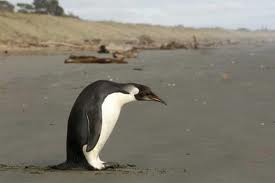
Thursday 23rd June
Happy feet is healthy and well feed he appears to be in very good condition and seems to be fishing in the ocean and eating well. Emperor Penguins eat fish, krill, squid and a wide range of marine invertebrates and hold the diving record at 450 metres deep and 11 minutes underwater.
He has plenty of fat on his body and is showing all the normal behaviours associated with Emperor Penguins. In the summer months Emperor penguins drink sea water so it is thought that he will do the same if he is thirsty.
Happy feet doesn't appear to be all that happy today he has started to move around less and the authorities are keeping a close eye on him.
It appears that he has been eating the sand on the beach which he cannot digest. In the Antarctic he would eat the snow for something to drink and also to cool himself off if he started to overheat.
The temperatures on the beach are between 14-19°C (degree centigrade) in New Zealand. Compare this to the winter temperature of-40 to -94°F (-40 to -70°C) in Antarctica.
This huge temperature difference has caused Happy feet to dehydrate. Especially if you add the fact that New Zealand sands warm up rather well. He is trying to cool himself the only way he knows how to, by trying to eat our snow which sadly is in fact sand. He has also been seen to have eaten a stick which could get caught and cause some serious health problems. Emperor penguins cannot digest any of these things.
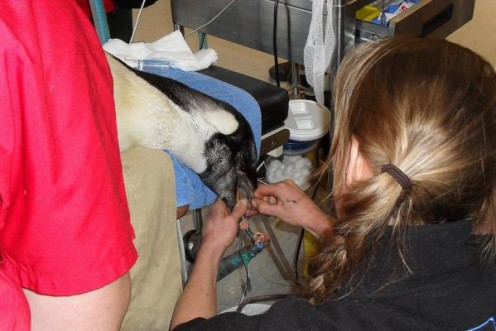
Friday 24th June
Sadly the vets at the Wellington zoo have had to step in and pick Happy feet up. The penguin was lying on its stomach with its head on the sand. He needed to have an umbrella held over him to stop him overheating any more then he was placed onto a giant ice cube to help him cool down. Both he and the ice cube were then transported to the Wellington zoo. It is thought that he has eaten too much sand or a stick that he has eaten has become lodged somewhere.
The vets have had to knock him out so they can place a tube down his airway and then try to get rid of as much of the sand from Happy feet’s stomach as they can. Vets have also taken x-rays, and blood samples to make sure nothing else is wrong with Happy feet. He has also been given a rehydration drip so hopefully he will start to recover soon. The vets are only giving him a 50/50 chance of survival at this point in time.
He underwent a four hour operation to clear his airway of sand with about 50 people watching the progress through the glass. They had to put antibiotic ointment into his ulcer covered sand filled eyes. Water was then slowly squirted down his throat until it dislodged the sand which flowed out into a bucket.
Vet science manager Lisa Argilla assessed the 27-kilogram bird. She determined that it was dehydrated, stressed, suffering from heat exhaustion and struggling to swallow - but it was still feisty enough to kick and struggle as she sedated him.
It appears that it was only due to National and International coverage of Happy Feet that he was given the chance to survive an email leaked shows that D.O.C was going to put Happy Feet down. Mr Stone in an email update to Ms Wilkinson and said his condition had deteriorated.
"A likely recommendation from vets will be to remove it from the beach [and therefore public view] to a clinic [Massey or possible Wellington Zoo] and then euthanasia."
Thank you to everyone for the support you all showed to this penguin saving him from this fate.
Happy Feet is unwell
What happens to Happy feet now
The next problem for Happy feet will be what to do with him once he recovers as he needs a place to stay for a few months. There is no way to get him back to Antarctica at the moment because there is only darkness there at this time of the year due to the fact that Antarctica only has 1 sunset and 1 sunrise every year. This means that for half the year it’s completely dark and the other 6 months it’s always daytime. Sadly planes don’t fly to Antarctica during its winter (dark) months.
Vets are worried that if they return Happy feet to the Antarctica he may take back with him bacteria or diseases that it may have picked up on either its way to New Zealand or since landing on the beaches here.
They are also worried that if they put him in with the other Emperor penguins in Kelly Tarlton's Aquarium in Auckland which has King and Gentoo Penguins but they are also concerned about disease.
“The zoo will be conducting further tests tomorrow. Mrs Argilla says the zoo doesn't like to euthanize healthy animals”.
There is a possibility it could go to a centre in America, but for now the specialists say they need to take it one step at a time.
I will keep everyone informed as to what is happening to Happy feet but for now this is all I know.
If you see this emperor penguin at another beach or to report unusual or injured marine animals contact the DOC Hotline: 0800 362 468
Happy Feets Xrays
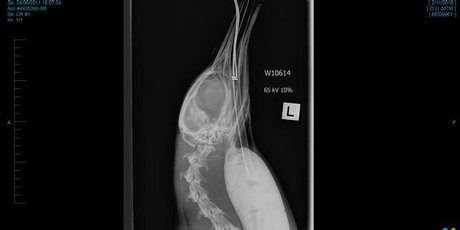
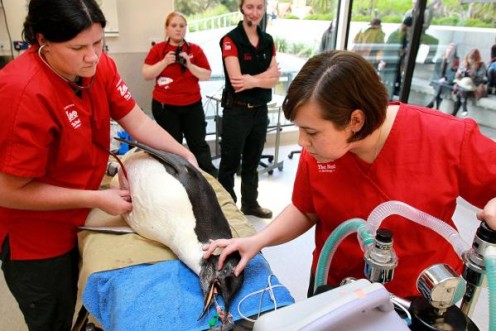
Saturday 25th June
Happy Feet is now in a critical condition following a second operation to clear sand from his system. About 75 people watched today's procedure, which was done by Dr Baukje Lenting and Dr Lisa Argilla of Wellington Zoo
X-rays have shown that there is still too much sand in the bird’s stomach and intestines so poor Happy feet needs to have a third operation to help clear his system so he can hopefully recover and go home to Antarctica.
They are probably doing the next operation on Monday so that he gets to have a bit of a rest. He has also passed some sand naturally and it is hoped that he will pass some more soon.
Lisa Argilla Vet science manager said ~
“It is too early to estimate the penguin's chances of survival, but it would be "amazing" if it pulled through”. "They can tolerate a fair amount of punishment, but it is a lot of sand that he's got in his intestines at the moment." “If the penguin does regain strength the best option would be to release it as far south as possible”.
Happy feet eatting sand
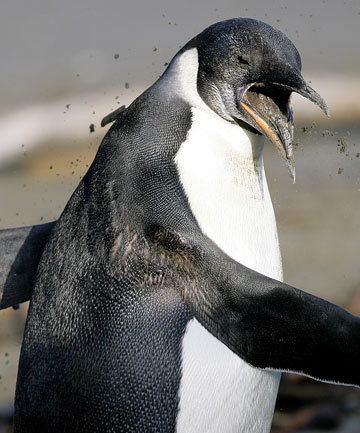
Sunday 26th June
Multimillionaire philanthropist Gareth Morgan has offered a seat to Happy Feet and a Conservation Department minder on a Russian icebreaker ship in February for an Our Far South expedition to the Ross Sea. Happy Feet will hopefully be well enough to go.
Gareth said that "Happy Feet was welcome to jump ship if it met other emperor penguins along the way".
Happy Feet will have to be cared for in Wellington until it’s time for him to take the trip home.
So now that Happy feet has a cruise ride back home he just needs to get better so that he can survive once he reaches his home waters.
Happy feet is still in a critical condition and Lisa fears that "the 3kg of sand is threatening to harden into concrete balls that could rupture the penguin's stomach". A camera is going to be put into Happy's stomach to see what’s going on tomorrow (endoscopy).
DNA taken from Happy feet should be back sometime this next week then we will all know whether Happy is a male or a female.
Where should Happy feet be sent once that is possable
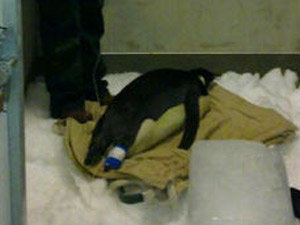
Monday 27th June
Dr John Wyeth a leading surgeon from Wellington Hospital performed the endoscopy on Happy Feet today. He said ~ "I think the important thing in this world is humanity and caring, and if we don't show that it doesn't reflect very well on our society.” It was reported that today there were hundreds of people watching Happy feet’s operation.
Twigs sticks and more sand were removed in today’s operation which took about 4 hours. Normally it would take about ½ an hour for a human but the Dr had to learn Happy’s passageways as he did the operation.
The staff at the Wellington Zoo said that Happy feet’s strength was returning. They also said that Happy is rather feisty and they have to be careful as he could break someone’s arm or leg easily.
Happy is staying in a special ice box that has given him a more familiar environment i.e. Snow and ice he can safely eat.
Happy feet's future being decided
The cost of housing Happy feet at the moment is being paid jointly by DOC and Wellington Zoo. Hopefully the zoo has taken a lot of extra income from all the people who wanted to watch the 3 operations. Also the zoo has had a lot of purchases of penguin toys etc. so this may help towards offsetting the costs of keeping Happy feet on a bed of party ice in a temperature-controlled room.
DOC biodiversity programme manager Peter Simpson said “This was by far the most bewildering conservation issue he had been involved in, It's way outside of its usual operating range, and that's why it's so extraordinary that it's survived." He also stated that they would discuss a permanent solution in the next few days.
A Massey University penguin expert, Associate Professor John Cockrem, said "choices included releasing the penguin into Foveaux Strait, or taking it back to Antarctica by boat or plane. If the penguin is released near Stewart Island, a tracking device could be used to follow its path."
The next trips to Antarctica are ~
Supply flights to Scott Base in August.
A Russian icebreaker ship in February.
DOC believes that transporting the bird would be risky - for both it and for the other penguins in Antarctica.
If the emperor penguin made it to Antarctica, then placing it with the other penguins could put that population at risk of contracting diseases Happy Feet may have picked up in New Zealand's more tropical climates.
Emperor penguins habitat
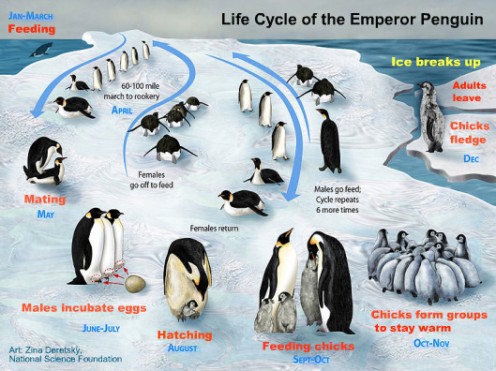
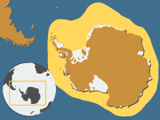
Why I believe they should take Happy feet back to Antarctica
Facts ~
If Happy feet is let go off the coast of New Zealand its chances of finding its way home are nearly nil.
As the above map shows Emperor penguins don’t come anywhere near New Zealand (the tiny Island in black at the bottom of the picture).
Happy feet needs to be taken to Antarctica or to an area Emperor penguins do frequent to have any chance of survival.
Happy feet is less than a year old (Emperor penguins get the yellow of an adult at 1 year old when they moult ~ shed their feathers which happen once a year. Sometime between December and February) the yellow colour gets brighter each year after that until the penguin has the brightest around 7 years of age.
Emperor penguins make their first return to the nesting colony at about 4 years old. Their age at first breeding is usually 5 to 6 years in males and 5 years in females. ~ This means that when Happy feet is dropped off onto an iceberg he won’t join a colony for another 3 years.
It would be highly improbable that Happy feet would carry any new diseases back to Antarctica that haven’t already been introduced by the migrating birds and sea life that Emperor penguins come into contact with yearly.
Happy has had bloods taken already to check to see if he/she is healthy.
According to National Geographic ~ Young emperor penguins travel far from the waters near their colonies. They can reach the sub Antarctic waters up to 12 degrees latitude away from their birth place. ~ This means that they can during their first 4 years of life travel into warmer waters and naturally come into contact with new viruses and germs.
I will let everyone know what is happening with Happy feet as soon as I find out however I don't see that there is any reason to not allow him to be returned to an iceberg in Antarctica.
Let me know what your thoughts are and please vote in my pole if you haven’t already done so.
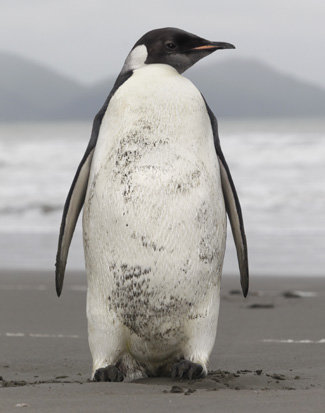
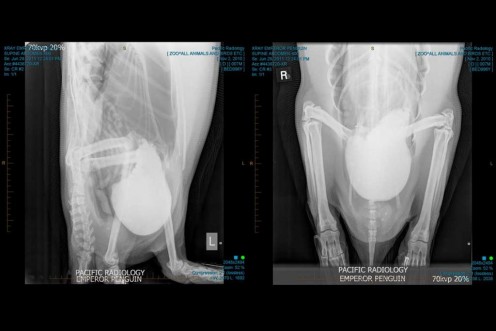
Tuesday 28th June
Around 2.5 kilos of sand, around 10% of the penguin's body weight, has been removed from Happy feet’s stomach.
It could take months before Happy feet is ready to be put back in the wild.
If Happy feet was taken to Antarctica in its current condition it could freeze to death.
One possibility is to move him to Kelly Tarlton's Underwater World in Auckland. Specialists say Happy feet would need to be kept in isolation from the other penguins in case it spreads disease.
Personally I'm unsure why they don’t just put Happy into quarantine then put him/her in with the other Emperor penguins like they did for Morgan ~A16-year-oldwhite-flippered penguin found lost and forlorn on the Banks Peninsula about three weeks ago. He has just been put in with the other penguins at Christchurch's International Antarctic Centre.
While Happy feet has been at the zoo he has shown some interest in the keepers and vets, using his flipper to touch them. ... (I bet he thinks we are unusual penguins)
Doctors hope that a combination of oily fish milkshakes, fluids and medication will help Happy feet pass the remaining sand and debris in his stomach naturally.
Lisa Argilla said “Yesterday he actually punched me in the stomach with his flipper." ~ I guess that means Happy's feeling better.
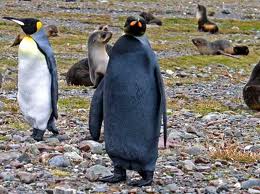
Interesting Fact
In 2010 the National geographic filmed and photographed a rare all black Emperor penguin.
Dr. Allan Baker, an ornithologist and head of the Department of Natural History at the Royal Ontario Museum basically said that it’s thought this is a one in a zillion find and an amazing mutation.
There may be another explanation for an all black Emperor Penguin. The penguin could possibly be a throwback to the ancient giant 4.5 foot tall penguins that roamed the earth centuries ago called the King Water Penguin. Emperor penguins are reported to be direct descendants of these ancient penguins.
click here to go to a hub about these prehistoric penguins
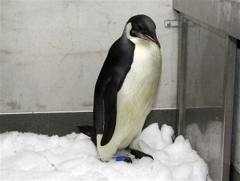
Wednesday 29th June
Dr. Allan Baker, an ornithologist and head of the Department of Natural History at the Royal Ontario Museum and a panel of experts from the zoo, the Department of Conservation, Massey University and The Papa met today to decide Happy feet’s future.
They have decided Happy feet should be released into the ocean, south-east of New Zealand.
The area is the northern edge of the known range of juvenile Emperor penguins and it is hoped, once it has recovered, it will be able to get back to normal life.
DOC biodiversity spokesperson Peter Simpson said ~ "The reason for not returning the penguin directly to Antarctica is that emperor penguins of this age are usually found north of Antarctica on pack ice and in the open ocean, “A tracking device could be attached to the penguin to follow its progress via satellite.
The penguin will not be released until it is deemed well enough to have a reasonable chance of survival. It will stay at Wellington Zoo in the meantime.
So it appears that Happy feet’s future has now been sealed. I must admit that I am still unsure why they won’t return him to the general area of Antarctica so he doesn't get lost again and end up in Australia or somewhere else.
I believe his chances of reaching Antarctica the way the officials have decided to do this are slim to none but perhaps that is why they are making this decision.
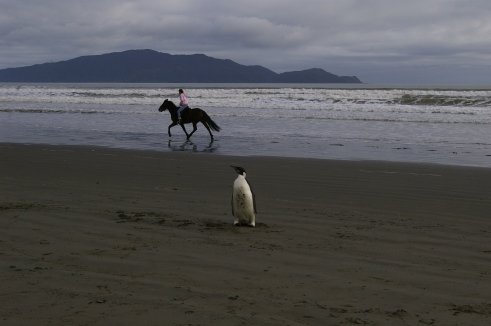
5th July ~ RETURNING PENGUIN TO ANTARCTICA 'ILLEGAL'
Antarctica New Zealand science manager Ed Butler says. ~The Antarctic Treaty, signed by 46 nations and enshrined in New Zealand law, stipulates that no living bird is allowed to be taken into Antarctica. Though the emperor penguin is native to the continent, taking him back there would breach the treaty's protocols on environmental protection because of the risk of disease
Lyn Stewart says~ It is possible to get a special permit that would allow Happy feet to be returned to Antarctica. It is also possible to set Happy feet free just outside Antarctica's boundary which would give Happy feet a good chance at survival.
Ed Butler says ~ Micro-organisms picked up on the penguin's 4000-kilometre swim to New Zealand or while on our shores could cause Happy Feet to become sick months down the track.
Lyn Stewart says ~ According to the vets that are taking care of Happy feet it will be at least 4 months before he/she is well enough to release. Emperor penguins come into contact with other species (even eat some of them) that travel to warm climates or waters every year so the chances of Happy feet bringing a new micro-organism into the area is remote.
Ed Butler says ~ "Even if we screened Happy Feet, we still couldn't be sure that he wouldn't be carrying something that would turn up in blisters and sores in six months' time and kill all his mates."
Lyn Stewart says ~ Due to the fact that Happy feet is less than a year old (since Emperor penguins get the first showing of yellow on their heads at their one year malting), Happy feet won’t join a colony until he/she is at least 4 years old (which is normal). If the screening of Happy feet (which has already happened when he was first taken to the Wellington zoo), by some miss-testing does not find something Happy feet will get ill way before he re-joins any colony at age 4 to try to breed for the first time.
Ed Butler says ~ Agriculture and Forestry Ministry research shows a suspected virus that struck a colony of Adelie penguins in Antarctica in 1972 killed 65 per cent of baby penguins in the colony of thousands. “There are 150,000 breeding pairs in some colonies, and 65 per cent of that is a big number," Butler said. "That's a lot of dead penguins for one penguin."
Lyn Stewart says ~ Then perhaps instead of letting Happy feet go back to the wild where there is in fact a possibility that he will make it home you should put him into a zoo to live with other Emperor penguins. I am assuming that you are not that worried about him spreading illness to the other Emperor penguins otherwise you wouldn't be letting him go back into the wild.
Unless of course the powers that be are positive he won't survive the long swim back home ~ surely they won’t set him free before he has recuperated for 3-4 months (the amount of time the head vets have said he needs to put on weight and recuperate) ~ especially since the vets have stated he is in poor condition and would freeze to death if he went home at this time.
Watch this space and I will keep you informed.
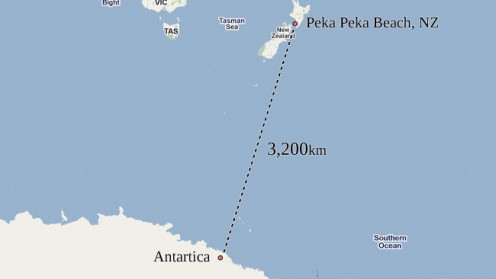
Live video of Happy feet
Click here to watch live video stream of Happy feet
Scientists have now confirmed that Happy feet is a boy penguin.
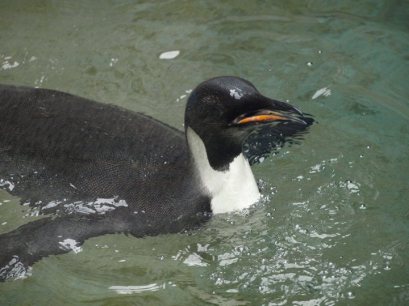
Happy Feet gets to have a swim
Luckily for Happy Feet, Wellington has been experiencing polar conditions and the largest snowfall in decades which has cooled down the pool at the Wellington Zoo. Happy feet took to the water finally able to have his first good swim on 25th July.
He also swam on the 14th-20th August. It was great that the vets were able to confirm he is waterproof and he has put on weight. He now weighs around 6kg’s more than when he did when he first arrived at the hospital. He is now nearly 27kg’s which is a healthy weight for a young penguin.
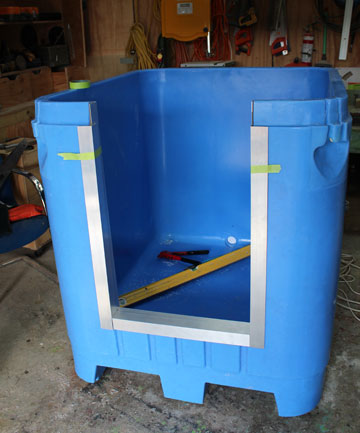
Happy Feet to be released near Cambell Island
Happy Feet is going to be released into sub Antarctic waters after he has had a satellite super glued to his lower back. He is going to have a special crate built for him and he is going to be taken by the Tangaroa which is one of NIWA’s research vessels. The satellite tag was constructed and donated by Sirtrack. The tag works by transmitting a signal every 45 seconds during the 7 hours each day that it turns itself on. The transmitter will be on between the hours of 6-9 am and 8pm-12am NZST. The information should give the location of happy feet of between a few hundred metres or a few kilometres if the signal is weak.
Happy feet will be released near Campbell Island which is 52.5 degrees south and around 1100 km north of Antarctica. I guess we will all be hoping that Happy Feet heads in the correct direction to get home and doesn’t run into any sharks or killer whales as he makes his own way home.
Hey where did that penguin come from
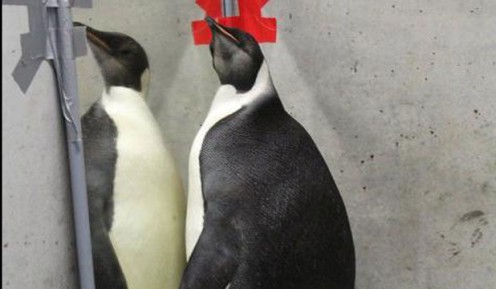
23rd August
A mirror has been placed into Happy Feet’s enclosure to provide him with some kind of stimulation now that he is well and active.
Ms Baker said "He seems to be very interested in the 'other' penguin."
Construction of Happy feet’s travel case is well underway and is being made out of the same material used on fishing vessels to hold fish in. The container is going to be large enough to lay down in, stand up in, turn around and lift his beak in comfort. It is also being made so that the area can be made smaller during bad weather. Hopefully the weather will be nice for him.
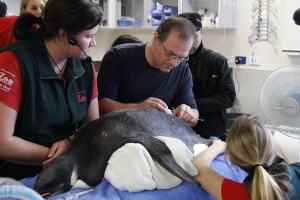
28th August
Hundreds of people came to Wellington Zoo today to watch Happy Feet’s sixth and final medical procedure. After being sedated Lisa Argilla gave Happy Feet a complete medical check. The GPS transmitter was also attached with super glue on his lower back down near his tail.
It was estimated that around 1700 visitors turned up to watch the procedures and say their farewells to Happy Feet. Due to the amount of people who wanted to see Happy Feet for a final time the visitors had to be rotated. People got to spend 5 minutes at the viewing windows before having to move on.
Dr Argilla who has cared for Happy Feet since he arrived at Wellington Zoo will be looking after him during the voyage. She will have the help of two NIWA biologists Dan MacGibbon and Neil Bagley.
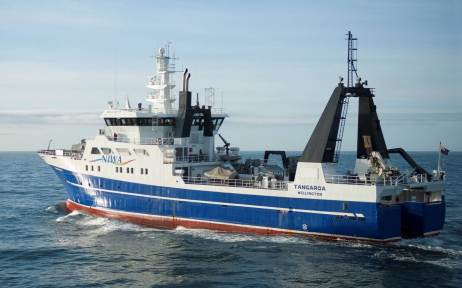
Monday 29th August
At 6pm the vessel Tangaroa set sail from Wellington harbour with Happy Feet and his vet minder Lisa Argile aboard. They headed out across Cook Strait then will follow the coastline down the east of the Mainland (South Island).
According to the blog from Lisa Happy feet is very excited about being back on the Ocean. She said ~ “He is curious and keeps trying to get out of his crate so he can go and jump in the ocean. I think he can smell the sea air as he seems to be doing a lot of sniffing at the air as well.”
It certainly sounds as if he wants to get back home soon.
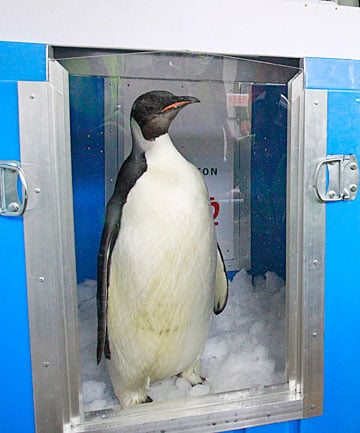
Wednesday 31 August
Lisa wrote in her blog today ~ "He tried to climb out of his crate this morning when we removed the lid! I bet he can't wait to be free now after sensing that he is on the ocean. He also beat Dan up after he was caught for his medication and food, just reminding us all who is boss I guess."
I have to admit to finding this rather amusing. So they are still travelling and it is still a while till they get to where Happy Feet is to be released. They have even created a slide which will be used by Happy Feet when he jumps ship. His container is tied securely to the deck of the ship so he is able to see the sea so to speak.
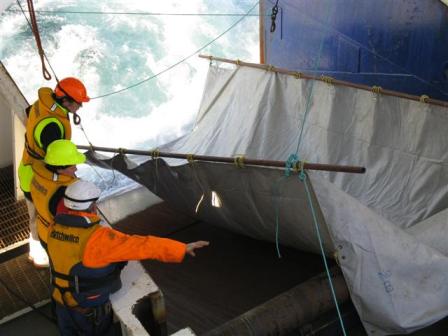
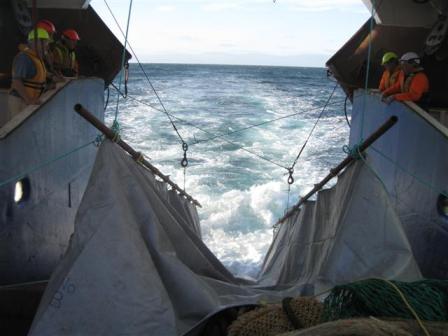
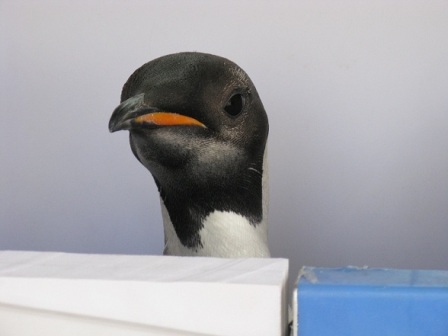
Thursday 1st September ~ Saturday 3rd September
It appears that during this time Happy Feet has been being a bit of a stroppy brat and taking every opportunity that has presented itself to bruise and beat up his minders. I guess he doesn't understand that they are trying to get him to an area that will give him the best chance to find his way home.
Also the weather has not helped making it too dangerous to release Happy Feet with swells between 4-8 feet over these 3 days.
All he is aware of is that after a few months he can again smell, taste and feel the ocean. So why is he not able to go swim in it like now! lol. He must be so peeved with his minders not letting him do what he wants to do. Kind of reminds you of toddlers doesn't it.
Anyway here are some of the more amusing things that Lisa has said in her blog ...
1st Sept ~ Mr Happy Feet is in a particularly cranky mood today. I was just leaning against his crate to try and keep my balance and he turned around and nipped me on the arm as if to say, "No leaning allowed, Missy". He managed to bruise Dan's bruises as well as being really stubborn with crop tubing for Neil.
2nd Sept ~ I was slipping and sliding around the crate this morning while trying to hold his mouth open for fish, and he took advantage of the fact that Dan and I were struggling...little fiend ;-).
3rd Sept ~ It was Penguin 10, Dan 0 after Dan's arm actually started bleeding after the flipper bashing HF gave him. Ah well, he will forever cherish the memory of being beaten up by an Emperor penguin ;-).
4th September ~ Happy Feet is released
Happy Feet was released 49 miles away from Campbell Island at 1028am NZST. He slid backwards down the cute after some gentle encouragement and disappeared into the ocean.
If you wish to track Happy Feet's progress over the next 7 or more weeks or you wish to leave a message of good luck then please click on the following link ~ http://www.ourfarsouth.org/Track-Happy-Feet.aspx
It appears that at the moment Happy Feet is at least heading in the right direction.
Thank - You
I would just like to take this opportunity to thank all the people who looked after Happy Feet.
Wellington Zoo vets and staff did an amazing job. If you want to check out Wellington Zoo click here.
Happy Feet is officially OFF the radar
On the 12th Sept Happy Feet's transmitter stopped working.
At first it was thought to be due to Solar flare disturbances. Sadly he has not been able to be found since this time on radar.
Our far south states that the most likely senario is that his tracking device has fallen off due to the severe weather ... It was only glued on after all.
All we can do now is hope that this is the case. This is the last update on Happy Feet. Thanks to everyone who has followed his progress.

